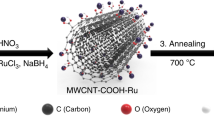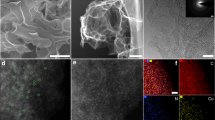Abstract
Oxygen electrocatalysis is of great importance for many energy storage and conversion technologies, including fuel cells, metal–air batteries and water electrolysis. Replacing noble metal-based electrocatalysts with highly efficient and inexpensive non-noble metal-based oxygen electrocatalysts is critical for the practical applications of these technologies. Here we report a general approach for the synthesis of hollow frameworks of nitrogen-doped carbon nanotubes derived from metal–organic frameworks, which exhibit higher electrocatalytic activity and stability for oxygen reduction and evolution than commercial Pt/C electrocatalysts. The remarkable electrochemical properties are mainly attributed to the synergistic effect from chemical compositions and the robust hollow structure composed of interconnected crystalline nitrogen-doped carbon nanotubes. The presented strategy for controlled design and synthesis of metal–organic framework-derived functional nanomaterials offers prospects in developing highly active electrocatalysts in electrochemical energy devices.
This is a preview of subscription content, access via your institution
Access options
Subscribe to this journal
Receive 12 digital issues and online access to articles
$119.00 per year
only $9.92 per issue
Buy this article
- Purchase on Springer Link
- Instant access to full article PDF
Prices may be subject to local taxes which are calculated during checkout







Similar content being viewed by others
References
Suntivich, J. et al. Design principles for oxygen-reduction activity on perovskite oxide catalysts for fuel cells and metal–air batteries. Nature Chem. 3, 546–550 (2011).
Bruce, P. G., Freunberger, S. A., Hardwick, L. J. & Tarascon, J. M. Li–O2 and Li–S batteries with high energy storage. Nature Mater. 11, 19–29 (2012).
Debe, M. K. Electrocatalyst approaches and challenges for automotive fuel cells. Nature 486, 43–51 (2012).
Wu, G. & Zelenay, P. Nanostructured nonprecious metal catalysts for oxygen reduction reaction. Acc. Chem. Res. 46, 1878–1889 (2013).
Borup, R. et al. Scientific aspects of polymer electrolyte fuel cell durability and degradation. Chem. Rev. 107, 3904–3951 (2007).
Meier, J. C. et al. Stability investigations of electrocatalysts on the nanoscale. Energy Environ. Sci. 5, 9319–9330 (2012).
Chen, Z., Higgins, D., Yu, A., Zhang, L. & Zhang, J. A review on non-precious metal electrocatalysts for PEM fuel cells. Energy Environ. Sci. 4, 3167–3192 (2011).
Li, Q., Cao, R., Cho, J. & Wu, G. Nanocarbon electrocatalysts for oxygen reduction in alkaline media for advanced energy conversion and storage. Adv. Energy Mater. 4, 1301415 (2014).
Liang, Y. et al. Co3O4 nanocrystals on graphene as a synergistic catalyst for oxygen reduction reaction. Nature Mater. 10, 780–786 (2011).
Yang, S., Feng, X., Wang, X. & Müllen, K. Graphene-based carbon nitride nanosheets as efficient metal-free electrocatalysts for oxygen reduction reactions. Angew. Chem. Int. Ed. 50, 5339–5343 (2011).
Zheng, Y. et al. Nanoporous graphitic-C3N4@carbon metal-free electrocatalysts for highly efficient oxygen reduction. J. Am. Chem. Soc. 133, 20116–20119 (2011).
Liang, Y., Li, Y., Wang, H. & Dai, H. Strongly coupled inorganic/nanocarbon hybrid materials for advanced electrocatalysis. J. Am. Chem. Soc. 135, 2013–2036 (2013).
Ma, T. Y., Dai, S., Jaroniec, M. & Qiao, S. Z. Graphitic carbon nitride nanosheet–carbon nanotube three-dimensional porous composites as high-performance oxygen evolution electrocatalysts. Angew. Chem. Int. Ed. 53, 7281–7285 (2014).
Bashyam, R. & Zelenay, P. A class of non-precious metal composite catalysts for fuel cells. Nature 443, 63–66 (2006).
Zheng, Y., Liu, J., Liang, J., Jaroniec, M. & Qiao, S. Z. Graphitic carbon nitride materials: Controllable synthesis and applications in fuel cells and photocatalysis. Energy Environ. Sci. 5, 6717–6731 (2012).
Chen, S., Duan, J., Jaroniec, M. & Qiao, S. Z. Nitrogen and oxygen dual-doped carbon hydrogel film as a substrate-free electrode for highly efficient oxygen evolution reaction. Adv. Mater. 26, 2925–2930 (2014).
Proietti, E. et al. Iron-based cathode catalyst with enhanced power density in polymer electrolyte membrane fuel cells. Nature Commun. 2, 416 (2011).
Liang, J., Jiao, Y., Jaroniec, M. & Qiao, S. Z. Sulfur and nitrogen dual-doped mesoporous graphene electrocatalyst for oxygen reduction with synergistically enhanced performance. Angew. Chem. Int. Ed. 51, 11496–11500 (2012).
Wang, H., Maiyalagan, T. & Wang, X. Review on recent progress in nitrogen-doped graphene: Synthesis, characterization, and its potential applications. ACS Catal. 2, 781–794 (2012).
Yang, W., Fellinger, T. P. & Antonietti, M. Efficient metal-free oxygen reduction in alkaline medium on high-surface-area mesoporous nitrogen-doped carbons made from ionic liquids and nucleobases. J. Am. Chem. Soc. 133, 206–209 (2011).
Li, Y. et al. An oxygen reduction electrocatalyst based on carbon nanotube-graphene complexes. Nature Nanotech. 7, 394–400 (2012).
Zhao, Y., Nakamura, R., Kamiya, K., Nakanishi, S. & Hashimoto, K. Nitrogen-doped carbon nanomaterials as non-metal electrocatalysts for water oxidation. Nature Commun. 4, 2390 (2013).
Wu, G., More, K. L., Johnston, C. M. & Zelenay, P. High-performance electrocatalysts for oxygen reduction derived from polyaniline, iron, and cobalt. Science 332, 443–447 (2011).
Gong, K., Du, F., Xia, Z., Durstock, M. & Dai, L. Nitrogen-doped carbon nanotube arrays with high electrocatalytic activity for oxygen reduction. Science 323, 760–764 (2009).
Yaghi, O. M. et al. Reticular synthesis and the design of new materials. Nature 423, 705–714 (2003).
Liu, B., Shioyama, H., Akita, T. & Xu, Q. Metal–organic framework as a template for porous carbon synthesis. J. Am. Chem. Soc. 130, 5390–5391 (2008).
Wang, C., Liu, D. & Lin, W. Metal–organic frameworks as a tunable platform for designing functional molecular materials. J. Am. Chem. Soc. 135, 13222–13234 (2013).
Palaniselvam, T., Biswal, B. P., Banerjee, R. & Kurungot, S. Zeolitic imidazolate framework (ZIF)-derived, hollow-core, nitrogen-doped carbon nanostructures for oxygen-reduction reactions in PEFCs. Chem. Eur. J. 19, 9335–9342 (2013).
Zhang, P. et al. ZIF-derived in situ nitrogen-doped porous carbons as efficient metal-free electrocatalysts for oxygen reduction reaction. Energy Environ. Sci. 7, 442–450 (2014).
Lin, Q. et al. New heterometallic zirconium metalloporphyrin frameworks and their teteroatom-activated high-surface-area carbon derivatives. J. Am. Chem. Soc. 137, 2235–2238 (2015).
Furukawa, H., Cordova, K. E., O’Keeffe, M. & Yaghi, O. M. The chemistry and applications of metal–organic frameworks. Science 341, 1230444 (2013).
Cao, R. et al. Promotion of oxygen reduction by a bio-inspired tethered iron phthalocyanine carbon nanotube-based catalyst. Nature Commun. 4, 2076 (2013).
Jiang, H. L. et al. From metal–organic framework to nanoporous carbon: Toward a very high surface area and hydrogen uptake. J. Am. Chem. Soc. 133, 11854–11857 (2011).
Aijaz, A., Fujiwara, N. & Xu, Q. From metal–organic framework to nitrogen-decorated nanoporous carbons: High CO2 uptake and efficient catalytic oxygen reduction. J. Am. Chem. Soc. 136, 6790–6793 (2014).
Wu, Z. S. et al. High-performance electrocatalysts for oxygen reduction derived from cobalt porphyrin-based conjugated mesoporous polymers. Adv. Mater. 26, 1450–1455 (2014).
Zhao, D. et al. Highly efficient non-precious metal electrocatalysts prepared from one-pot synthesized zeolitic imidazolate frameworks. Adv. Mater. 26, 1093–1097 (2014).
Zhao, D. et al. Iron imidazolate framework as precursor for electrocatalysts in polymer electrolyte membrane fuel cells. Chem. Sci. 3, 3200–3205 (2012).
Zhang, W., Wu, Z. Y., Jiang, H. L. & Yu, S. H. Nanowire-directed templating synthesis of metal–organic framework nanofibers and their derived porous doped carbon nanofibers for enhanced electrocatalysis. J. Am. Chem. Soc. 136, 14385–14388 (2014).
Su, P. et al. Nitrogen-doped carbon nanotubes derived from Zn–Fe–ZIF nanospheres and their application as efficient oxygen reduction electrocatalysts with in situ generated iron species. Chem. Sci. 4, 2941–2946 (2013).
Sun, J. K. & Xu, Q. Functional materials derived from open framework templates/precursors: Synthesis and applications. Energy Environ. Sci. 7, 2071–2100 (2014).
Hu, M. et al. Direct carbonization of Al-based porous coordination polymer for synthesis of nanoporous carbon. J. Am. Chem. Soc. 134, 2864–2867 (2012).
Ma, S., Goenaga, G. A., Call, A. V. & Liu, D. J. Cobalt imidazolate framework as precursor for oxygen reduction reaction electrocatalysts. Chem. Eur. J. 17, 2063–2067 (2011).
Jaouen, F., Serventi, A. M., Lefèvre, M., Dodelet, J. P. & Bertrand, P. Non-noble electrocatalysts for O2 reduction: How does heat treatment affect their activity and structure? J. Phys. Chem. C 111, 5971–5976 (2007).
Chung, H. T., Won, J. H. & Zelenay, P. Active and stable carbon nanotube/nanoparticle composite electrocatalyst for oxygen reduction. Nature Commun. 4, 1922 (2013).
Tian, J. et al. Optimized synthesis of Fe/N/C cathode catalysts for PEM fuel cells: A matter of iron–ligand coordination strength. Angew. Chem. Int. Ed. 52, 6867–6870 (2013).
Wang, L., Ambrosi, A. & Pumera, M. ‘Metal-free’ catalytic oxygen reduction reaction on heteroatom-doped graphene is caused by trace metal impurities. Angew. Chem. Int. Ed. 52, 13818–13821 (2013).
Lefèvre, M., Proietti, E., Jaouen, F. & Dodelet, J. P. Iron-based catalysts with improved oxygen reduction activity in polymer electrolyte fuel cells. Science 324, 71–74 (2009).
Deng, D. et al. Iron encapsulated within pod-like carbon nanotubes for oxygen reduction reaction. Angew. Chem. Int. Ed. 52, 371–375 (2013).
Xiong, W. et al. 3-D carbon nanotube structures used as high performance catalyst for oxygen reduction reaction. J. Am. Chem. Soc. 132, 15839–15841 (2010).
Liang, H. W., Zhuang, X., Brüller, S., Feng, X. & Müllen, K. Hierarchically porous carbons with optimized nitrogen doping as highly active electrocatalysts for oxygen reduction. Nature Commun. 5, 4973 (2014).
Acknowledgements
We acknowledge financial support from the academic research fund AcRF Tier 1 (M4011253, RG 7/14) and Tier 2 (M4020246, ARC10/15) Ministry of Education, Singapore. This project is also funded by the National Research Foundation (NRF), Prime Minister’s Office, Singapore under its Campus for Research Excellence and Technological Enterprise (CREATE) programme.
Author information
Authors and Affiliations
Contributions
B.Y.X., X.W.L. and X.W. conceived the project and co-wrote the manuscript. B.Y.X. carried out the synthesis. B.Y.X., Y.Y., N.L. and H.B.W. conducted the materials characterization and the electrochemical evaluation. B.Y.X. and Y.Y. contributed equally to this work. All authors read and commented on the manuscript.
Corresponding authors
Ethics declarations
Competing interests
The authors declare no competing financial interests.
Supplementary information
Rights and permissions
About this article
Cite this article
Xia, B., Yan, Y., Li, N. et al. A metal–organic framework-derived bifunctional oxygen electrocatalyst. Nat Energy 1, 15006 (2016). https://doi.org/10.1038/nenergy.2015.6
Received:
Accepted:
Published:
DOI: https://doi.org/10.1038/nenergy.2015.6
This article is cited by
-
Operando formation of highly efficient electrocatalysts induced by heteroatom leaching
Nature Communications (2024)
-
Metal–organic framework-derived cobalt nanoparticles modified nitrogen-doped porous carbon hybrids for efficient hydrogenation and one-pot reductive acetylation of nitroarenes
Reaction Kinetics, Mechanisms and Catalysis (2024)
-
Deoxyribonucleic acid scaffolded and encapsulated one-dimensional gadolinium(III) hydroxide nanorods for supercapacitors and oxygen evaluation reaction properties
Advanced Composites and Hybrid Materials (2024)
-
Hollow Metal–Organic Framework/MXene/Nanocellulose Composite Films for Giga/Terahertz Electromagnetic Shielding and Photothermal Conversion
Nano-Micro Letters (2024)
-
Formation of hierarchically 3D cactus-like architecture as efficient Mott-Schottky electrocatalyst for long-life Li−S batteries
Nano Research (2023)



